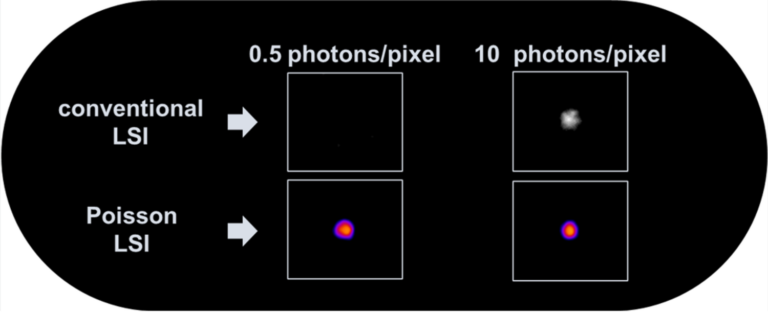< Back
Intensifier Control
HiCAM Fluo enables object recognition at subphoton/pixel light levels
Reducing sample irradiation prevents photobleaching and phototoxicity, resulting in longer sample lifetimes and less background fluorescence. Light-sheet microscopy, in which a sheet of light passes through the specimen rather than the whole sample being illuminated, reduces the light irradiation of the sample by an order of magnitude compared to confocal microscopy.
Tristin Sanchez et al. developed a light-sheet imaging system that reduces specimen irradiation by an additional order of magnitude, decreasing photobleaching and phototoxicity to a greater degree. Imaging at these low light levels has its challenges, since the signals are at comparable levels as the background noise.
Decreasing the specimen exposure is reached by operating at the Poisson limit. This requires detectors capable of detecting single photons with very low dark and read noise. To achieve this, the HiCAM Fluo is integrated in the imaging system. With its 1280 x 1024 CMOS sensor and double stage intensifier, the HiCAM Fluo is capable of single photon detection with minimal background noise.
Operation at the Poisson limit is reached by integrated illumination combined with single photon detection and wavelet-based image reconstruction. Working at this limit enables imaging with fewer than one photon per pixel, which reduces photo illumination of the specimen drastically compared to other modern techniques.

Figure 1: Four images obtained from conventional light-sheet imaging and Poisson light sheet imaging, demonstrating increased contrast for Poisson light sheet imaging at subphoton per pixel intensities. Figuretaken from: [1]
Figure 1 shows four images. The upper two are taken with a conventional light-sheet imaging technique and the lower images are obtained with light-sheet imaging at the Poisson limit (after wavelet transform of the signal). It follows that an object can be recognized with as little as 0.5 photons per pixel when operating at the poisson limit. This is approximately a 20-fold decrease of photons per pixel needed for object recognition compared to conventional light-sheet imaging.
Tristin Sanchez et al. developed a light-sheet imaging system that reduces specimen irradiation by an additional order of magnitude, decreasing photobleaching and phototoxicity to a greater degree. Imaging at these low light levels has its challenges, since the signals are at comparable levels as the background noise.
Decreasing the specimen exposure is reached by operating at the Poisson limit. This requires detectors capable of detecting single photons with very low dark and read noise. To achieve this, the HiCAM Fluo is integrated in the imaging system. With its 1280 x 1024 CMOS sensor and double stage intensifier, the HiCAM Fluo is capable of single photon detection with minimal background noise.
Operation at the Poisson limit is reached by integrated illumination combined with single photon detection and wavelet-based image reconstruction. Working at this limit enables imaging with fewer than one photon per pixel, which reduces photo illumination of the specimen drastically compared to other modern techniques.


